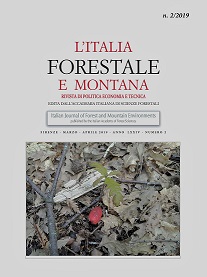Published
2019-08-22
Keywords
- temperature and rainfall trends,
- water balance,
- climate-vegetation relationship,
- forest renaturalisation,
- Vallombrosa Abbey,
- Italy
...More
Less
Abstract
The Italian more-than-one-hundred-year-old meteorological series show - with only few exceptions - the increase of air temperature along with the decrease of precipitations. Temperature and rainfall data recorded at Vallombrosa Abbey (955 m a.s.l.) from 1872 to 2017 confirm the negative trend of precipitations while showing a substantial stability of temperatures, as a result of winter and spring rise being hardly higher than summer and autumn decrease. The slight spring rise in temperatures is related to the productivity of the tree stand, reducing of a few units the annual number of “cold days” (Tave<7,0°C), with positive consequences upon the xylogenesis after the winter stasis. The persistence of the present trends in the western Mediterranean basin can produce significant effects in the areas of Tuscany that were already suffering from meteorological and hydrological drought, such as the islands of the Archipelago and the coastal strip south of Leghorn, but so far it has only produced minor effects in the average and high mountains of the Apuan Alps and of the Tuscan-Emilian Apennines. The average records, the ranges and trends of water balance parameters (Thornthwaite, 1948) show a slight increase of potential evapotranspiration, a remarkable decrease of water surplus and a weak increase of deficit, and consequently a reduction of the global moisture index. Consequences of such trends upon the tree species that are most demanding in soil moisture in the Forest of Vallombrosa (Silver Fir, Beech) are discussed. In the last decades (1980-2017), due to the strong increasing trend of summer temperatures and despite a decreasing trend of total precipitations in the same season that is weaker than the general one, a significant reduction of the amount of water available to plants is recorded. The study of climatic parameters enabling arboreal plants life-cycle is made uncertain by the present phytogeographical set in Tuscany, which has been deeply altered by human intervention in the last centuries. The detection of remains of native vegetation and of the related climatic parameters would provide useful information to try and renaturalize damaged or modified ecosystems: Campolino spruce forest (“pigelleto Chiarugi”), in the high Sestaione Valley, meets the first requirement, but it is not equipped with a meteorological station, while Boscolungo (Abetone Pass, Pistoia), next to the spruce forest, offers a meteorological series long and reliable enough to be studied


